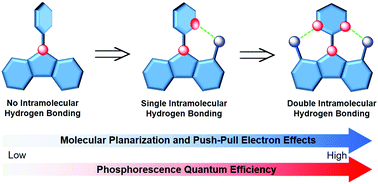Modulation of the intramolecular hydrogen bonding and push–pull electron effects toward realizing highly efficient organic room temperature phosphorescence†
Abstract
The exploitation of ultralong organic room temperature phosphorescence (UORTP) materials lags far behind the need because of the lack of general design strategies. Here we proposed a facile design strategy based on the structural control of intramolecular hydrogen bonding (IHB) and push–pull electron effects (PPEEs) to construct highly efficient UORTP materials. Two series of carbazole derivatives with different IHBs and PPEEs were designed accordingly. By enhancing the IHB interactions of the luminophores, the molecular planarity, intermolecular interactions and packing mode were effectively tuned, facilitating the intermolecular electron coupling. PPEEs, enhanced by introducing heteroatoms and heavy atoms, strengthened the intramolecular charge transfer states, which changed the orbital transition configuration of excited states, thus boosting the intersystem crossing (ISC) and spin–orbit coupling (SOC). Consequently, CzPM and CzPMBr with dual IHBs and the strongest PPEEs exhibited ultralong lifetimes (τP) of 1.31 s and 233 ms with the highest phosphorescence quantum yields (ΦP) of 1.7% and 48.6% in their series, respectively. Theoretical investigations revealed that the high-lying intersystem crossing (HISC) between excited singlet states (Sm, m > 1) and triplet states (Tn, n > 1) occurred and played a vital role in enhancing the ΦP values of UORTP materials. Significantly, the SOC matrix elements between S3 and T7 (ξ(S3,T7)) of CzPMBr reached up to 39.95 cm−1. Finally, CzPMBr was successfully used as an anti-counterfeiting ink in calligraphy and painting due to its excellent RTP properties. The design strategy based on the structural control of IHBs and PPEEs will greatly widen the design platform of UORTP materials. Meanwhile, the discovery of the HISC process will also provide a new insight for the design of UORTP materials.

- This article is part of the themed collections: 2023 Journal of Materials Chemistry C Lunar New Year collection, 2022 Journal of Materials Chemistry C Most Popular Articles and Journal of Materials Chemistry C Emerging Investigators


 Please wait while we load your content...
Please wait while we load your content...